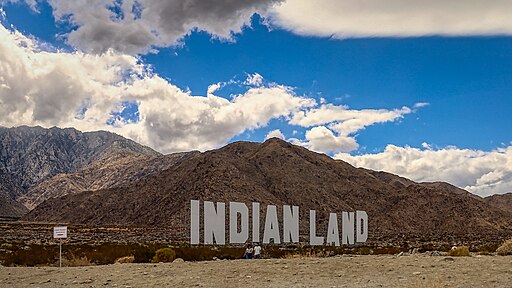
The Role of Local Public Agencies in Land Back
June 7, 2024Photo: “Never Forget,” an installation by Tlingit and Unangax̂ artist Nicholas Galanin in Palm Springs, Calif., in 2021, calling for return of land to the Cahuilla people. Photo credit: Dale Cruse, CC BY 2.0, via Wikimedia Commons
The Land Back Movement
Many Native American Tribes have a sacred and ongoing relationship with their ancestral lands. But Tribes have been forcibly removed from their lands, often for little or no compensation, through centuries of colonization. As a result, most of the land in the United States is now under private or public ownership. “Land Back” is an Indigenous-led movement that aims to strengthen tribal sovereignty and support cultural revitalization by putting land back into the hands of Native American Tribes and peoples.
Sogorea Te’ and the City of Oakland: A Success Story
The East Bay, including Oakland, is the ancestral homeland of the Ohlone people. In 2022, the City of Oakland partnered with the Sogorea Te’ Land Trust, an Indigenous women-led non-profit, and the East Bay Ohlone Tribe, the Confederated Villages of Lisjan Nation, to return five acres of City-owned land to Indigenous stewardship. The City granted the Land Trust a cultural conservation easement in perpetuity, which allows it to use the land for natural resource restoration and cultural practices, such as gathering native plants and foods. The Land Trust also intends to build a structure that will be used as both a ceremonial gathering place and a space to provide public education on tribal culture. The easement is an example of a successful partnership between a Tribe and an agency in the Land Back effort.
Steps for Agencies that Would Like to Participate
Because public agencies often own land and control access to it, or exercise influence on the use of land by private entities, they can play an important role in the Land Back movement. However, navigating the process of returning land to Tribes requires thoughtful planning. Below are some helpful steps and considerations for any agencies interested in participating in Land Back.
- Identify potential sites: First, the agency must identify the site(s) that it would like to return to Indigenous stewardship. To make the land eligible for a transfer, the agency may need to fulfill certain legal requirements, such as compliance with the Surplus Land Act. The agency should also keep in mind that land return can take different forms, many of which do not involve transfer of fee title, as discussed below.
- Identify the affiliated Tribe: After the agency has identified an eligible parcel of land, it should then identify the Tribe that it will partner with. To do so, the agency must determine which Tribe(s) is/are ancestrally affiliated with the subject land. The California Native American Heritage Commission maintains a list of Tribes that is a commonly used resource for this task, but agencies should be aware that the regulations governing the list are currently under review. Agencies should view the list as a starting place, but will also need to conduct additional research, including through direct communication with area Tribes.
- Reach out to the Tribe: Once the agency has identified the Tribe with ancestral ties to the subject land, it can begin engaging in conversations with the Tribe. Some agencies may already have an established relationship due to prior consultation. If the agency has not had prior communications with the Tribe, then early conversations should focus on building a relationship and gaining an understanding of each party’s goals. For example, some Tribes have more capacity and resources than others, which may impact their ability to take on land management, especially without financial support. Further, Tribes have differing goals in their intended use for the land: some may want to use the land for ceremony or resource gathering, while others may want to take on a more involved role in stewardship.
- Decide on the form of the land return: Based on the goals and resources of the Tribe, the agency should then consider the form it would like the transfer to take. On one end of the spectrum, there is transfer of fee title, where the agency grants the Tribe legal ownership of the land. On the other end of the spectrum, there is an access license, where the agency retains ownership but grants the Tribe some access for ceremonies, resource gathering, or other cultural activities. There are also several options in the middle of the spectrum, such as a conservation easement, where the Tribe owns the land but the agency places permanent restrictions on the way it can be used. Determining the appropriate transfer mechanism should be based on conversations and the development of mutual expectations between the agency and the Tribe, as well as the requirements of any necessary grant or other funding.
- Seek legal counsel: Whatever form of land return the agency and Tribe decide on, land transfers and easements can be complex transactions, raising questions around such issues as tribal sovereign immunity. Thus, it is important to seek legal advice during this process.
The Path Forward
Because land return can take many forms and the interests, priorities, resources, and governing structure of each Tribe is different, public agencies must approach the process with care and open communication. As made clear by the recent success in Oakland, partnerships between public agencies and Tribes present a vital opportunity for progress in the Land Back movement.
For more information on how your agency can participate in the Land Back movement, contact Shasta Fields.